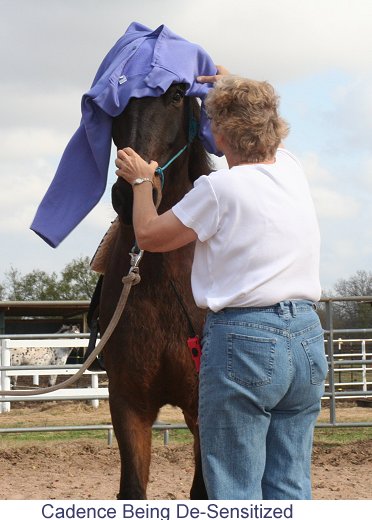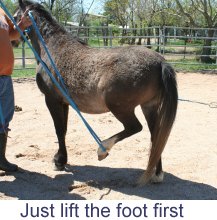 Each time you introduce a new move, your horse is building on past maneuvers.
Each time you introduce a new move, your horse is building on past maneuvers.
That is one reason that it is advisable to follow the steps in the Horse Training Exercises in order. Each lesson builds on the previous lesson. You may not see the importance of any particular lesson at any particular time, but, down the line you will regret having skipped a step.
Introduce new exercises in baby steps.
Break them down into small pieces, and teach him one piece at a time. An oft repeated saying of horse trainers is, “We get there faster by going slower”. If he gets confused or you hit a roadblock, back up to the last step he mastered well and practice it again – ending each exercise with a familiar and well-polished exercise. ie: If you want him to disengage his front, accept one step over at first. Allow him to digest it a few moments.
When one step is accomplished consistently, ask for two steps, then ask for three, then ask for a complete circle. Accept small victories and quit while you are ahead. Stop if you feel like you are pushing too hard.
Learn about Signal time. Give him ample aids and lead up to the maneuver consistently and slowly, building from “anticipate” to “request” to “demand”. Each maneuver cue starts with a subtle action such as just picking up the reins. Then it moves to a change in your position in the saddle (lean forward). Then adds verbal “cluck”. Then moves to leg pressure (squeeze buttocks), then moves to demanding leg (spur or crop).
 Build the routine of your cues first. He will anticipate your request based on the sequence and begin to act at an earlier and earlier stage of the routine until the cues are so subtle no one can even see them. Shaping is refining his response. Eventually you will have the entire multi-step maneuver accomplished.
Build the routine of your cues first. He will anticipate your request based on the sequence and begin to act at an earlier and earlier stage of the routine until the cues are so subtle no one can even see them. Shaping is refining his response. Eventually you will have the entire multi-step maneuver accomplished.
(This is very much akin to learning to dance if you have any experience with that. You start with the basic step and then add the next fancy step until you have a routine that goes several maneuvers in a chain. The leader is the horse trainer, who must think ahead to each step and use understandable body language. The follower is the horse, who must learn the “signal” to perform the steps.)
Notice that the rider MUST be trained before the horse is trained. If you cannot master the cue sequences, the horse will never master the lesson.
Change only one portion of an exercise at a time.
Environment is also a “portion”. Once the horse has mastered the exercise in the round pen, move to the arena. Once mastered there, move to the pasture. Once mastered there, move to the trail. Don’t forget that you must teach an exercise on both sides of your horse before considering it mastered. (see Two Brains)
The same rule applies to changing equipment. Change only one portion or attribute at a time. If you are introducing a new bit, keep as many parts of the old bit mechanism in the new bit with only one change. ie: if you want to introduce your horse to leverage, choose a bit mouth that is exactly like his old bit but with short cheeks. Don’t go from conventional snaffle bit to a conventional curb bit in one step. Keep the two-piece mouthpiece and add small shanks such as a Kimberwick bit or Pelham. Then change to a longer shank but with same mouthpiece. Then change to a different mouth with the same configuration of cheeks etc. etc.
This bit-changing sequence requires more bits during his training, but will make transitions easier and faster.
How often can you train? My experience has shown that a 1 hour session is usually plenty – especially for a novice trainer. You should start by warming up with familiar and easily-rewarded maneuvers. When your horse is relaxed during the warm-ups, then proceed to a new lesson. If things start to get stressful, retreat to an easier maneuver and then return to the new moves. End on a relaxed note of familiar maneuvers.
If you have time to train two times a day, you may – as long as the horse has complete, unstressed rest for a couple of hours between sessions. Two hours of grazing or lounging seems to be as good as “sleeping on it”. Start early morning. Train again in the evening. This schedule really speeds things up if you are a weekend-only trainer.
Horse training and equestrian activities in general can be dangerous. While we try to present relevant and valuable content, under no circumstances does horse-pros.com or its members or contributors take any responsibility for the well-being of any horse or person using a method outlined here.
We certainly don’t know everything. Please share your expertise and experiences. Comment on what is already written or Suggest a Category and Educate us about it. Grow Horse-Pros.com©